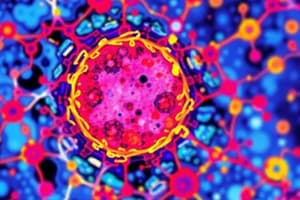Podcast
Questions and Answers
What is the primary function of the Golgi apparatus?
What is the primary function of the Golgi apparatus?
- Package and distribute proteins and lipids (correct)
- Produce ribosomes
- Store nutrients and water
- Produce ATP
All living things are made up of cells.
All living things are made up of cells.
True (A)
Who discovered that all plants are made of cells?
Who discovered that all plants are made of cells?
Matthias Schleiden
The ___ is responsible for producing energy in the form of ATP.
The ___ is responsible for producing energy in the form of ATP.
Match the following organelles with their functions:
Match the following organelles with their functions:
Which of the following microscopes can only examine non-living cells?
Which of the following microscopes can only examine non-living cells?
Centriole is found in both plant and animal cells.
Centriole is found in both plant and animal cells.
What is the function of the cytoskeleton?
What is the function of the cytoskeleton?
The cell membrane is also known as the ___ membrane.
The cell membrane is also known as the ___ membrane.
Which of these organelles is primarily involved in lipid production?
Which of these organelles is primarily involved in lipid production?
Flashcards
Compound Light Microscope
Compound Light Microscope
A microscope that uses light and lenses to magnify images of cells and other small objects.
Electron Microscope
Electron Microscope
A microscope that uses beams of electrons to produce images of very small objects, including organelles.
Cell
Cell
The basic unit of structure and function in all living organisms.
Cell Membrane
Cell Membrane
Signup and view all the flashcards
Cytoskeleton
Cytoskeleton
Signup and view all the flashcards
Nucleus
Nucleus
Signup and view all the flashcards
Mitochondria
Mitochondria
Signup and view all the flashcards
Chloroplast
Chloroplast
Signup and view all the flashcards
Cell Wall
Cell Wall
Signup and view all the flashcards
Lysosomes
Lysosomes
Signup and view all the flashcards
Study Notes
Microscopy
- Compound light microscopes can examine living cells but magnify up to only 1000x, insufficient for most organelles.
- Electron microscopes can magnify up to 2,000,000x, examining non-living cells and structures inside or on their surfaces.
Cell Theory
- All living things are made of cells.
- Cells are the basic unit of structure and function in an organism.
- All cells come from pre-existing cells.
- Schleiden (1838): discovered all plants are made of cells.
- Schwann (1839): discovered all animals are made of cells.
- Virchow (1855): discovered all cells come from pre-existing cells.
Cellular Organization
- Cells are the foundational units for biological organization.
- Levels of organization progress from smallest to largest: Organelle → Cell → Tissue → Organ → Organ System → Organism
Cell Membrane
- Also known as the plasma membrane or phospholipid bilayer.
- Function: Acts as a barrier between the cell's interior and the environment, with selective permeability.
- Components:
- Phospholipids: Major membrane component.
- Proteins: Facilitate substance transport.
- Carbohydrates: Aid in cell recognition.
Cytoskeleton
- Function: Provides cell shape, movement, and division.
- Examples: cilia, flagella, pseudopod, and centrioles.
Centrioles
- Part of the cytoskeleton involved in cell division.
- Found only in animal cells.
Cytoplasm
- Includes cytosol (gel-like fluid), cytoskeleton, and organelles.
Nucleus
- Contains DNA (genetic information).
- Controls cell activities.
- Found only in eukaryotic cells.
Ribosomes
- Synthesize proteins.
- Can be free-floating in the cytoplasm or bound to the rough endoplasmic reticulum.
Endoplasmic Reticulum
- Smooth ER: Lacks ribosomes; produces lipids, ships to Golgi, and breaks down toxins.
- Rough ER: Contains ribosomes; produces and ships proteins to the Golgi.
Golgi Apparatus
- Receives proteins and lipids from the ER.
- Packages and distributes them throughout the cell.
Vacuoles
- Membrane-bound spaces for temporary storage (ions, nutrients, water, waste).
- Plant cells have a large central vacuole, maintaining turgor pressure.
Lysosomes
- Membrane-bound pouches with enzymes to break down waste, materials, and invaders.
- Found only in animal cells.
Mitochondria
- Found in all eukaryotic cells.
- Generates ATP (energy) during cellular respiration using glucose.
Chloroplasts
- Found in plant cells and certain protists.
- Conduct photosynthesis, converting light energy into glucose.
Cell Wall
- Rigid structure outside the cell membrane in plants, fungi, and some protists.
- Provides support and protection.
Extracellular Matrix (ECM)
- Found in animal cells.
- Functions: Supporting, adhering, moving and regulating the cell.
Cell Type Differences
- Animal cells: Contain lysosomes, centrioles, cilia, and flagella.
- Plant cells: Contain a cell wall, chloroplasts, and a large central vacuole.
Studying That Suits You
Use AI to generate personalized quizzes and flashcards to suit your learning preferences.




